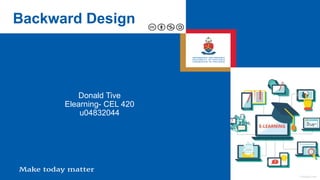
Backward design
- 1. Backward Design Donald Tive Elearning- CEL 420 u04832044 Freepik.com
- 2. Backward design Who developed the backward design model? What is backward design? How does backward design work? Why should one use the backward design model? In this lesson, I will answer the following questions
- 3. Backward design? • The Backward design model was developed by Wiggins & McTighe (2005) in their book titled “Understanding by Design”. • This model assumes a three-phased process, which inverts the typical design process
- 4. Backward design? • The Backward design model was developed by Wiggins & McTighe (2005) in their book titled “Understanding by Design”. • This model assumes a three-phased process, which inverts the typical design process 1. Identify intended learning outcomes This model inverts the general idea of beginning the design process with the content in mind, and it instead proposes that the ultimate learning objectives should be the first and foremost starting point in the instructional design process. • Clear and specific learning outcomes should be developed with use of Blooms taxonomy
- 5. Backward design? • The Backward design model was developed by Wiggins & McTighe (2005) in their book titled “Understanding by Design”. • This model assumes a three-phased process, which inverts the typical design process 1. Identify intended learning outcomes This model inverts the general idea of beginning the design process with the content in mind, and it instead proposes that the ultimate learning objectives should be the first and foremost starting point in the instructional design process. • Clear and specific learning outcomes should be developed with use of Blooms taxonomy 2. Determine the appropriate assessment criteria Having already identified the intended learning outcomes, the next step is to determine the appropriate assessment criteria that defines what constitutes evidence of learning or achievement of intended learning outcomes. • To ensure the alignment of the curriculum and the assignments (constructive alignment design, Biggs (2003)), appropriate Blooms verbs should be used to define the assessment criteria.
- 6. Backward design? • The Backward design model was developed by Wiggins & McTighe (2005) in their book titled “Understanding by Design”. • This model assumes a three-phased process, which inverts the typical design process 1. Identify intended learning outcomes This model inverts the general idea of beginning the design process with the content in mind, and it instead proposes that the ultimate learning objectives should be the first and foremost starting point in the instructional design process. • Clear and specific learning outcomes should be developed with use of Blooms taxonomy 2. Determine the appropriate assessment criteria Having already identified the intended learning outcomes, the next step is to determine the appropriate assessment criteria that defines what constitutes evidence of learning or achievement of intended learning outcomes. • To ensure the alignment of the curriculum and the assignments (constructive alignment design, Biggs (2003)), appropriate Blooms verbs should be used to define the assessment criteria. 3. Plan the learning opportunity and a suitable instructional method • Once you have identified the intended learning outcomes, and defined the assessment criteria, the final step is to plan and design the learning opportunity using instructional methods which are suitable for the achievement of the intended learning outcomes and its associated assessment criteria.
- 7. Backward design? • The Backward design model was developed by Wiggins & McTighe (2005) in their book titled “Understanding by Design”. • This model assumes a three-phased process, which inverts the typical design process 1. Identify intended learning outcomes This model inverts the general idea of beginning the design process with the content in mind, and it instead proposes that the ultimate learning objectives should be the first and foremost starting point in the instructional design process. • Clear and specific learning outcomes should be developed with use of Blooms taxonomy 2. Determine the appropriate assessment criteria Having already identified the intended learning outcomes, the next step is to determine the appropriate assessment criteria that defines what constitutes evidence of learning or achievement of intended learning outcomes. • To ensure the alignment of the curriculum and the assignments (constructive alignment design, Biggs (2003)), appropriate Blooms verbs should be used to define the assessment criteria. 3. Plan the learning opportunity and a suitable instructional method • Once you have identified the intended learning outcomes, and defined the assessment criteria, the final step is to plan and design the learning opportunity using instructional methods which are suitable for the achievement of the intended learning outcomes and its associated assessment criteria. • Backward design is a model that forces one to state a learning objective and map a way to reach that specific learning objective. • Such an approach prioritizes achieving learning objectives and provides the lecturer with enough flexibility to design means of achieving the goal. • It is also a suitable model of ensuring the constructive alignment of objectives, assessments and learning activities
- 8. Backward design? Anderson, L. W., & Krathwohl, D. R. (2001). A taxonomy for learning, teaching, and assessing: A revision of Bloom's taxonomy of educational objectives. New York: Longman. Biggs, J. (2003) Aligning teaching for constructing learning . The Higher Education Academy Wiggins, G., & McTighe, J. (2005) Understanding by design (2nd ed.). Alexandria, VA: Association for Supervision and Curriculum Development ASCD PotentiallyCoherent. (2015, April 26). Backward design process. Retrieved from: https://www.youtube.com/watch?v=QbKx_tG99ho References
Editor's Notes
- Click through the slide
- I have merged 3 slides into 1 for visual presentation
- I have merged 3 slides into 1 for visual presentation
- I have merged 3 slides into 1 for visual presentation
- LiveSlide https://directpoll.com/r?XDbzPBd3ixYqg84Htlyyz9LRW5lQw7fByQ4HgMgN